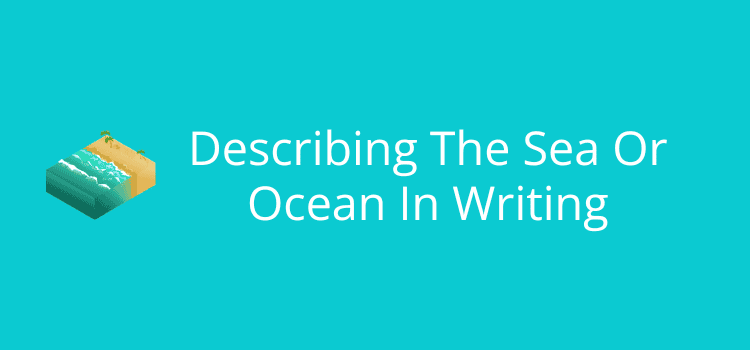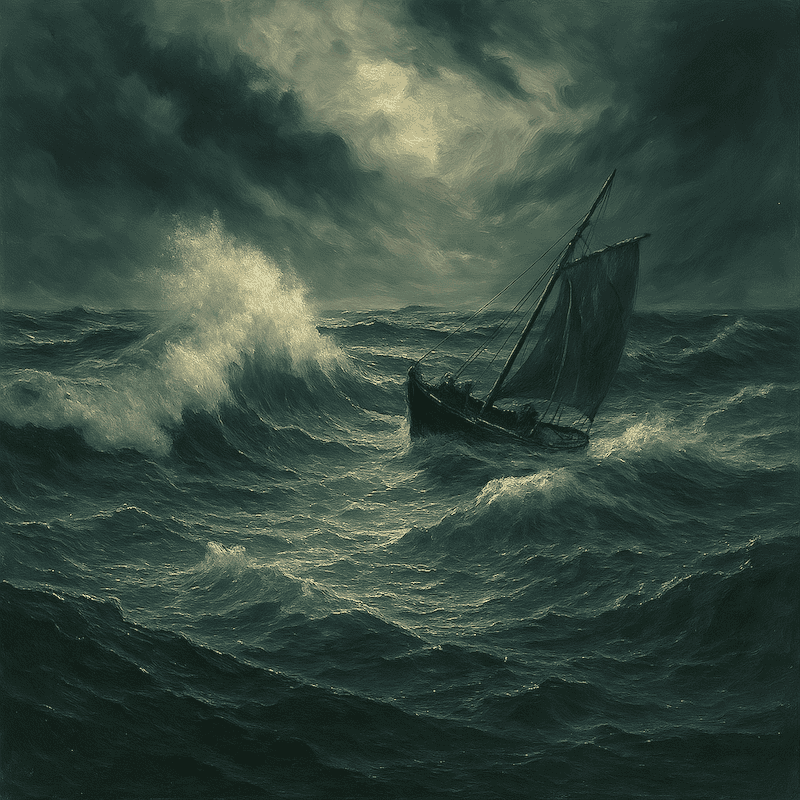
When you want to describe the sea or ocean in a novel, don’t write a report; write a scene.
What’s the difference? “The sea was rough, and the wind was strong.” This is a report, not unlike a television weather report.
Now, here’s a quick example of a scene. “Waves rose in jagged, angry white peaks, with the vicious wind snapping at the rigging like a wild beast.”
You can see the difference immediately, but how do you find the right vocabulary and phrases?
Think about senses when you describe
One of the easiest ways to describe things like the weather or a night is to think about how it can relate to the five senses.
Here are some quick examples for water, sea, and oceans.
Sight: green swells, white caps, the horizon
Sound: wind howling, waves crashing
Smell: brine, engine fumes, seaweed
Touch: cold, the sting of rain
Taste: salty, briny
You don’t have to use all of them, but making a quick list like this gives you a starting point for your description.
Once you’ve got a list, you can move on to crafting the details into your scene.
Maybe the icy nip of sea spray hits your character’s cheeks, or the taste of caking salt on their lips as they yell above the storm.
Details like this don’t just paint a picture; they help a reader feel and sense a scene.
The more specific you are, the more vivid the scene.
Instead of simply saying, “the sea was rough,” you might describe “waves spanking the hull like the tail of an angry whale.”
You certainly don’t want to overload every paragraph, but you do need to create the scene.
You don’t have to use only your mind’s eye
Writing is mostly from your imagination.
However, taking advantage of new technology can help you develop your descriptive passages a little easier.
Instead of simply imagining, you can create images to help you look and investigate.
It’s very easy now to create images using artificial intelligence (AI) tools.
And yes, I know how some writers feel about AI, but this is a practical use, and for your use only, and not for publishing.
You can use any tool, but I created the image below using Bing Copilot.
My first prompt was, “Create an image of the sea was rough, and the wind was strong.” But I wasn’t happy with the result, so I added this follow-up prompt.
“Can you add a small boat in difficulty to the image?” Here’s the result.

As a visual aid, the image has elements that make it easier to describe because they are right in front of you.
It has the waves, clouds, horizon, moonshine, and a small boat battling the elements.
If you want to take AI a step further, you could ask ChatGPT, like I did, to describe the image. You’re certainly not going to use it, but it can give you some clues.
“The sea roared beneath a bruised sky, its waves rising like mountains, capped with foam that caught what little light pierced the storm. A lone fishing boat battled the chaos, its sail straining against the wind like a torn banner in retreat. Every crest threatened to swallow it whole, while the wind howled like a beast, lashing the water into a frenzy. The sailors were shadows, hunched and braced, as if clinging not just to the boat, but to life itself. In the distance, the clouds split with a ghostly glow, hinting at a moon long hidden—watching, indifferent.”
Sure, it’s over the top, long-winded, and unusable, but there are some snippets in there that could help you describe the scene, such as bruised sky, light pierced the storm, and a moon long hidden.
The ocean and sea in literature
Sea and ocean settings have often been used in literature. It never hurts to study a few to give you some inspiration.
Here are some quick examples.
Ernest Hemingway, The Old Man and the Sea:
“The sea was as smooth as a plate-glass window. He could see the shadow of the fish in the water.”
Kate Chopin, The Awakening:
“The voice of the sea is seductive; never ceasing, whispering, clamoring, murmuring, inviting the soul to wander.”
Herman Melville, Moby-Dick:
“There is, one knows not what sweet mystery about this sea, whose gently awful stirrings seem to speak of some hidden soul beneath.”
From Lord of the Flies by William Golding:
“The water was warmer than his blood and he might have been swimming in a huge bath. He struck out by himself and the glittering sea passed him by. The edge of the lagoon became a streak of phosphorescence which advanced minutely, as the great wave of the tide flowed.”
From Life of Pi by Yann Martel:
“The sea roared like a tiger. The sky bled red. The wind was a pack of wolves—all hunger and teeth. My skin was slashed by rain. Salt stung my eyes and mouth. The boat pitched and rolled as if tossed by some unseen hand.”
One take from these examples, and particularly the last two, is the use of the senses to help a reader feel the scene.
Summary
Describing something you can’t see, like pain, is always a challenge.
However, for visual elements, it’s much easier, because if you can see it, you can describe it.
When you try to describe the sea or ocean, don’t write a report.
Think about the five senses, even if you only use one or two to help you write a compelling scene.
You could use the hiss of spray, the sting of salt, or the heave of waves to add sensory details and movement.
And if you get stuck, create an AI-generated image to help you picture the moment more vividly.
Remember, it’s only a quick creative shortcut, just like looking at reference images or photos, but faster. You can use this trick for any situation or topic.
Literature is always a source of inspiration. When you find great examples, examine the rhythm, senses, or emotional impact, and then try to create your own.
The last point is to think about your reader.
How can you make them hear, smell, taste, and see the scene? When you can do that, you have succeeded.
Related Reading: Describe Silence In Writing Without Saying “It Was Quiet”
Share This Article


